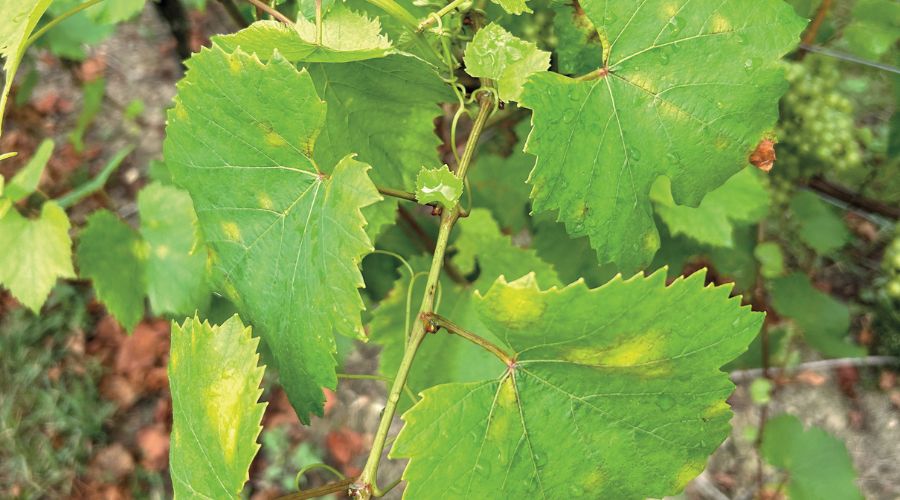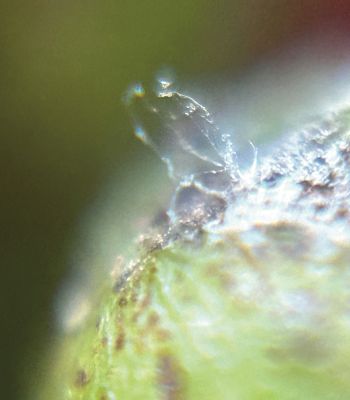Post-harvest pest and disease management
18th January 2025
In the first of a new series of topical updates, Agrovista fruit and vines agronomist Fokion Chatziavgerinos examines the importance of post-harvest pest and disease management to ensure the long-term vitality of top fruit and grapevines.

After harvest, plants remain susceptible to pests and diseases that can affect their health and next season’s production. Applying nutrition after harvest while leaves are present ensures efficient nutrient absorption and translocation to roots and storage tissues.
This aids active photosynthesis that supports energy production, improving recovery after fruiting and preparing trees and vines for the following year, by maximising nutrient uptake and promoting stronger growth.
Top and stone fruit
Where there was scab presence during the growing season, at least one application of a protectant fungicide, such as Delan Pro, dithianon or Captan, can reduce the risk of scab inoculum build-up in the following season.
Fungicides with curative activity should be avoided during leaf-fall as scab is going through its sexual phase, producing pseudothecia, so resistant strains may develop when DNA recombines. In orchards with low canker risk, urea can be applied to reduce scab inoculum. To comply with Red Tractor requirements, inhibited/methylene urea can be used.
During autumn leaf-fall the risk of apple canker is high, especially in wet autumns, which can lead to a high occurrence of shoot dieback the following season. In apple and pear orchards where canker was an issue, post-harvest fungicide applications are required and should be timed with Agrovista’s Fruit Insight Neonectria canker model. When the risk is highest, tebuconazole can be applied once per season; elsewhere Captan applications provide adequate protection.
In orchards where codling presence was high and crop damage was noted, autumn and spring applications of Koppert’s Capirel nematodes will reduce the population carryover by 60–80% for the following season and reduce the risk for the next crop.
Forest bug populations also need monitoring at this time. Forest bugs overwinter as second instar nymphs and during spring they start feeding on young buds, flowers and fruits.
Pear orchards with a history of pear bud weevil should be monitored post-harvest and insecticide application might be required, based on pressure.
Pear sucker populations require assessment between harvest and leaf fall. If populations of nymphs are high, application of Flipper or applications of EpsoTop with Roller, an organosilicone surfactant, can help contain the negative effect of honeydew.
Phosphite application on stone fruit will enhance the defence mechanisms of the trees, reducing their susceptibility to bacterial canker.
Proper nutrition between harvest and leaf-fall will have a positive impact on next season’s growth by fortifying the formation of new buds, promoting pollen tube growth and fruit set development. Nitrogen and potassium support early growth in the next season. Phosphorus promotes optimal bud development, early root establishment, and new tissue growth for the following spring. Calcium strengthens the tree tissue and ensures continued photosynthetic activity, increasing the reserves for dormancy.
Top and stone fruit growers can benefit from two applications of Agrovista 16–8–2 foliar feed plus Agrovista Ca at 14-day intervals. In addition, ground application of calcium nitrate to Cox, Bramley, Egremont Russet and Braeburn, as well as ammonium nitrate on heavy-cropping dessert varieties (>50t/ha) such as Gala are recommended.
Similarly, on stone fruit crops, application of calcium and ammonium nitrate is recommended (amount should be related to crop load and age of the trees).
Vines

In vineyards where adequate disease control was carried out over the growing season, little action is required post-harvest. Conversely, insufficient in-season control combined with a wet autumn may necessitate post-harvest treatments to reduce carryover.
For many vine growers, 2024 has been a challenging year in terms of downy mildew events due to wet conditions, which has clearly demonstrated the value of our Fruit Insight downy mildew model.
Copper application is recommended immediately after harvest, to target downy mildew sporangiospores on the leaves, when the conditions are still mild and before thick-walled overwintering oospores form.
Nutrition-wise, a balanced post-harvest fertilisation programme, combined with proper irrigation and soil health management, helps replenish reserves, support root development and ensure strong bud formation for the following growing season.
Loss of foliage due to downy mildew will have an impact on photosynthesis and, in turn, carbohydrate reserves, which provide the energy required for absorbing minerals.
Nitrogen applications can assist with maintaining leaf function, while potassium and phosphorus aid root health and improve the vine’s resilience to environmental stresses. Potassium also plays a key role in sugar transport and is important for future fruit development. Application of zinc and boron ensure healthy vines and optimal grape production in the next season.
About our expert
Fokion Chatziavgerinos joined Agrovista’s highly regarded team of fruit specialists in 2021, advising on tree fruit and vines across the south of England and Wales. Key interests include integrated pest management, plant pathology, fruit tree nutrition and fruit crop physiology.
Read more fruit news.
